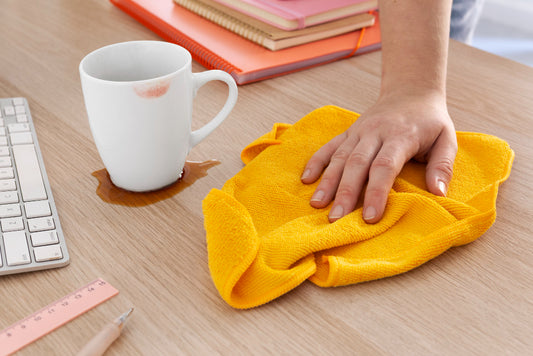Pet ownership brings immeasurable joy and companionship, but it also entails a unique set of challenges when it comes to maintaining a clean and hygienic living space. From muddy paw prints to shedding fur, our furry friends can leave their mark on our floors. In this comprehensive guide, we'll explore the vital role of mops in pet-friendly homes, offering practical tips to ensure a clean and harmonious living environment for both pets and their owners.
1. Understanding the Challenges:
Paw Prints and Shedding Fur:
- While the love and loyalty of pets are unparalleled, the aftermath of muddy paw prints and shedding fur can pose cleaning challenges. Pet-friendly homes require effective cleaning strategies to address these issues and maintain a clean and odor-free atmosphere.
2. The Importance of Regular Cleaning:
Preventing Buildup:
- Regular cleaning is the first line of defense against the accumulation of pet-related messes. Promptly addressing paw prints, fur, and any accidents prevents these issues from becoming ingrained in flooring and surfaces, making the cleaning process more manageable.
3. Choosing the Right Mop for Pet-Friendly Homes:
Microfiber Mops for Fur Removal:
- Microfiber mops are highly effective in capturing and removing pet fur from various surfaces. Their electrostatic charge attracts and holds onto loose fur, preventing it from being redistributed in the air or settling on furniture.
Sponge Mops for Accidents:
- Sponge mops with absorbent heads are ideal for quickly addressing pet accidents. Their ability to soak up liquids helps in efficient cleanup, and the smooth sponge surface is easy to sanitize after use.
4. Tips for Mopping Pet-Friendly Spaces:
Pre-Mop with a Vacuum or Broom:
- Before reaching for the mop, pre-mop the area using a vacuum or broom to remove loose dirt, debris, and fur. This minimizes the risk of spreading these particles during the mopping process.
Choose Pet-Safe Cleaning Solutions:
- When using cleaning solutions, opt for those labeled as pet-safe. Harsh chemicals can be harmful to pets, especially if they come into contact with freshly cleaned surfaces. Look for eco-friendly and pet-safe cleaning options.
Spot Clean High-Traffic Areas:
- Focus on spot cleaning high-traffic areas where your pet spends most of their time. These areas are more prone to dirt, fur, and paw prints, and targeted cleaning helps maintain cleanliness throughout the home.
5. Addressing Paw Prints and Dirt:
Microfiber Mop Pads for Hard Floors:
- Microfiber mop pads are excellent for hard floors such as tile, hardwood, or laminate. They effectively capture dirt, mud, and paw prints, providing a thorough cleaning without scratching or damaging the floor.
Steam Mops for Sanitization:
- Steam mops not only clean but also sanitize surfaces, making them a valuable tool in pet-friendly homes. The high-temperature steam kills bacteria and germs, ensuring a hygienic environment for both pets and humans.
6. Managing Pet Odors:
Utilize Odor-Neutralizing Solutions:
- Pet odors can be a persistent challenge. Incorporate odor-neutralizing solutions into your mopping routine. Solutions containing natural ingredients like baking soda or enzymatic cleaners can help eliminate unpleasant smells.
Regular Washing of Mop Heads:
- Pet odors can linger in mop heads, especially after cleaning up accidents. Regularly wash and sanitize mop heads to prevent the transfer of odors to different areas of the home.
7. Paw Maintenance:
Keep Paw-Cleaning Supplies Handy:
- Place a designated area near entry points with paw-cleaning supplies. A microfiber mat or pet-friendly wipes can help minimize the dirt and mud your pet brings into the house.
Regular Paw Cleaning Routine:
- Establish a routine for cleaning your pet's paws, especially after outdoor activities. This proactive approach reduces the likelihood of paw prints and dirt making their way into your home.
8. Upholstery and Fabric Care:
Vacuum Upholstery and Bedding:
- Pet fur tends to accumulate on upholstery and bedding. Use a vacuum with upholstery attachments to regularly clean these surfaces, preventing fur buildup.
Wash Pet Bedding Frequently:
- Pet beds can harbor odors and fur. Wash pet bedding frequently, and consider using removable, machine-washable covers for easy maintenance.
9. Preventive Measures:
Trim Your Pet's Nails Regularly:
- Long nails can scratch and damage floors. Regularly trim your pet's nails to prevent scratches and reduce the wear and tear on flooring surfaces.
Protect High-Risk Areas:
- Place mats or rugs in high-risk areas where your pet is likely to track in dirt or moisture. These protective measures help contain messes and make cleaning more efficient.
10. Embracing Pet-Friendly Mop Innovations:
Paw-Cleaning Stations:
- Some innovative mop designs include built-in paw-cleaning stations. These features, often found in entryway mats or mop buckets, provide a convenient way to clean your pet's paws before they enter the house.
Pet-Specific Cleaning Tools:
- Explore pet-specific cleaning tools, such as handheld vacuums designed for pet hair or mop attachments tailored for fur removal. These specialized tools can enhance your cleaning arsenal in pet-friendly homes.
A Harmonious Home for Humans and Pets:
Maintaining a clean and harmonious living space in a pet-friendly home requires a strategic approach, with the right mop playing a central role. By choosing the appropriate mop for different tasks, adopting effective cleaning techniques, and incorporating preventive measures, pet owners can strike a balance between a welcoming home and the inevitable challenges of pet-related messes. With the right tools and a proactive mindset, homes can be transformed into havens where both humans and their furry companions can thrive in a clean and happy environment.




